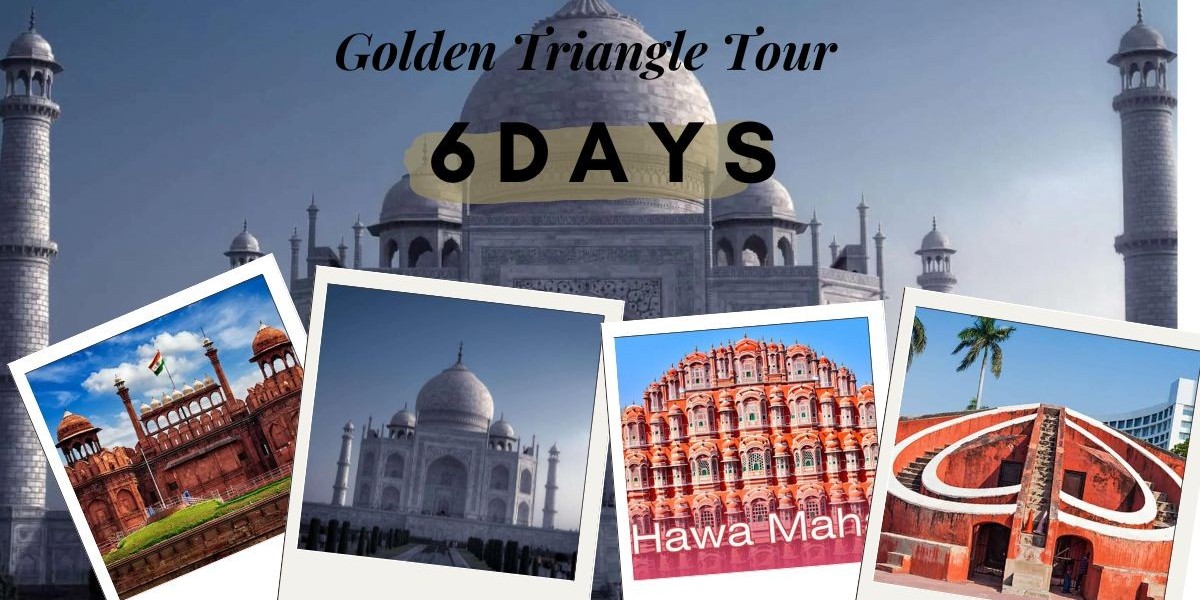Golden Triangle Tour is one of the most popular travel routes in India, taking travelers through the country's most iconic cities—Delhi, Agra, and Jaipur. Over 6 days, this tour offers a deep dive into India’s cultural heritage, architectural brilliance, and vibrant traditions. The Golden Triangle forms a geographical triangle on the map, connecting Delhi, Agra, and Jaipur. This journey is perfect for travelers who want to experience India's rich history and diverse culture in a relatively short period of time.
In this blog, we’ll cover the detailed itinerary of the Golden Triangle Tour 6 Days, explore the important places, and discuss how this tour offers valuable insights into Indian culture, traditions, and history.
Overview of the Golden Triangle Tour
The Golden Triangle includes three cities:
- Delhi: India’s capital city, a mix of ancient Mughal architecture and modern urban life.
- Agra: Home to the Taj Mahal, one of the Seven Wonders of the World.
- Jaipur: The capital of Rajasthan, also known as the Pink City, famous for its forts, palaces, and royal heritage.
These cities capture the essence of India's past and present, making the Golden Triangle Tour a quintessential experience for any traveler.
Itinerary of the Golden Triangle Tour 6 Days
Day 1: Arrival in Delhi – The Gateway to India
Your journey begins in Delhi, a city where history meets modernity. Upon arrival, check into your hotel and get ready to explore some of the city's most important landmarks.
- Important Places to Visit:
- Qutub Minar: A UNESCO World Heritage Site and the tallest brick minaret in the world.
- Humayun's Tomb: The precursor to the Taj Mahal, an architectural gem of the Mughal era.
- India Gate: A war memorial that honors the soldiers who died in World War I.
- Lotus Temple: Known for its flower-like architecture, this temple is a place for meditation and peace.
- Red Fort: A massive Mughal fort that served as the residence of emperors for centuries.
Cultural Insight: Delhi’s rich blend of Mughal architecture, colonial heritage, and bustling streets reflects India’s historical evolution from the 16th century to modern times.
Day 2: Delhi Sightseeing and Transfer to Agra
Begin your second day with a hearty breakfast and continue exploring Delhi before heading to Agra.
- Additional Sights in Delhi:
- Jama Masjid: One of the largest mosques in India, built by Shah Jahan.
- Raj Ghat: A memorial dedicated to Mahatma Gandhi.
- Chandni Chowk: One of the oldest and busiest markets in Old Delhi, where you can experience traditional Indian street food and shop for local handicrafts.
After exploring Delhi, embark on a 3-4 hour drive to Agra, where you will spend the night.
Day 3: Agra – Home of the Taj Mahal
Agra is synonymous with the Taj Mahal, one of the most famous monuments in the world. After breakfast, your day will be dedicated to exploring this city’s Mughal-era treasures.
- Important Places to Visit:
- Taj Mahal: Visit this UNESCO World Heritage Site early in the morning to witness its breathtaking beauty at sunrise. Built by Emperor Shah Jahan in memory of his wife Mumtaz Mahal, the Taj Mahal is a symbol of eternal love.
- Agra Fort: Another UNESCO-listed site, this massive red sandstone fort served as the residence of Mughal emperors.
- Mehtab Bagh: A beautiful garden located across the Yamuna River from the Taj Mahal, offering stunning views of the monument, especially at sunset.
Cultural Insight: Agra’s Mughal architecture showcases the blend of Persian and Indian art, reflecting the grandeur of the Mughal Empire.
Day 4: Agra to Jaipur via Fatehpur Sikri
After visiting Agra’s major attractions, drive towards Jaipur. On the way, stop at Fatehpur Sikri, a deserted city built by Emperor Akbar.
- Important Places to Visit:
- Fatehpur Sikri: A UNESCO World Heritage Site and former capital of the Mughal Empire. Key attractions include the Buland Darwaza, Panch Mahal, and Jama Masjid.
Arrive in Jaipur by evening, check into your hotel, and enjoy a relaxing night in the Pink City.
Day 5: Jaipur – The Pink City of India
Jaipur is famous for its royal heritage, vibrant bazaars, and magnificent forts and palaces. Start your day with a guided tour of the city’s top attractions.
- Important Places to Visit:
- Amber Fort: A grand hilltop fort built with red sandstone and marble. Don’t miss the Sheesh Mahal (Mirror Palace) inside.
- Hawa Mahal (Palace of Winds): Known for its unique honeycomb structure, this palace was built for royal women to observe street festivals without being seen.
- City Palace: A complex of courtyards, gardens, and buildings that reflect the city’s royal history.
- Jantar Mantar: A UNESCO-listed astronomical observatory that demonstrates the scientific advancements of ancient India.
Cultural Insight: Jaipur, with its pink-hued buildings and grand palaces, offers a glimpse into Rajasthan's royal history and traditional craftsmanship, from block-printed textiles to exquisite jewelry.
Day 6: Jaipur to Delhi – The End of Your Journey
On the final day of your tour, enjoy breakfast at your hotel and take a leisurely stroll around Jaipur before heading back to Delhi.
If time permits, you can visit:
- Nahargarh Fort: Offering panoramic views of Jaipur.
- Albert Hall Museum: Showcasing Rajasthani art and history.
Afterward, drive back to Delhi or head directly to the airport for your onward journey.
Important Places in the Golden Triangle Tour
- Delhi: Red Fort, Qutub Minar, Humayun’s Tomb, India Gate, Lotus Temple, Jama Masjid.
- Agra: Taj Mahal, Agra Fort, Mehtab Bagh, Fatehpur Sikri.
- Jaipur: Amber Fort, Hawa Mahal, City Palace, Jantar Mantar, Nahargarh Fort.
How the Golden Triangle Tour Teaches You About Indian Culture and Traditions
The Golden Triangle Tour is an immersive cultural journey that provides a deep understanding of India's history, traditions, and daily life. Here’s how:
- Architectural Heritage: The tour covers India’s most significant architectural marvels, each representing a unique blend of Hindu, Islamic, and Persian influences.
- Cultural Experiences: Exploring bustling markets, traditional crafts, and tasting local food in each city gives you an authentic insight into Indian life.
- Royal Legacy: From Delhi’s Mughal rulers to Jaipur’s Rajput kings, the tour showcases the grandeur and legacy of India’s past empires.
- Traditions: Witness local artisans creating traditional handicrafts, such as block-printing in Jaipur or marble inlay work in Agra.
Essential Points About the Golden Triangle India Tour Package
- Duration: The tour typically lasts 6 days, offering a well-paced itinerary with ample time to explore each city.
- Best Time to Visit: The best time to embark on the Golden Triangle Tour is between October and March when the weather is pleasant for sightseeing.
- Transportation: Private cars with air conditioning are typically provided for comfort. You may also opt for train travel between cities for an authentic Indian experience.
- Guides: Private guides in each city provide expert insights into the historical and cultural significance of each monument.
- Accommodation: The tour includes stays in comfortable 4 or 5-star hotels that offer a relaxing end to each day.
Conclusion
The Golden Triangle Tour 6 Days is an ideal way to explore India’s rich cultural heritage, historical landmarks, and vibrant traditions. From the grandeur of Delhi’s Mughal monuments to the majestic beauty of the Taj Mahal and the royal allure of Jaipur, this tour offers a well-rounded introduction to India’s glorious past. Whether you’re a history buff, a culture enthusiast, or simply looking for a memorable experience, the Golden Triangle Tour is the perfect gateway to discovering the essence of India.








